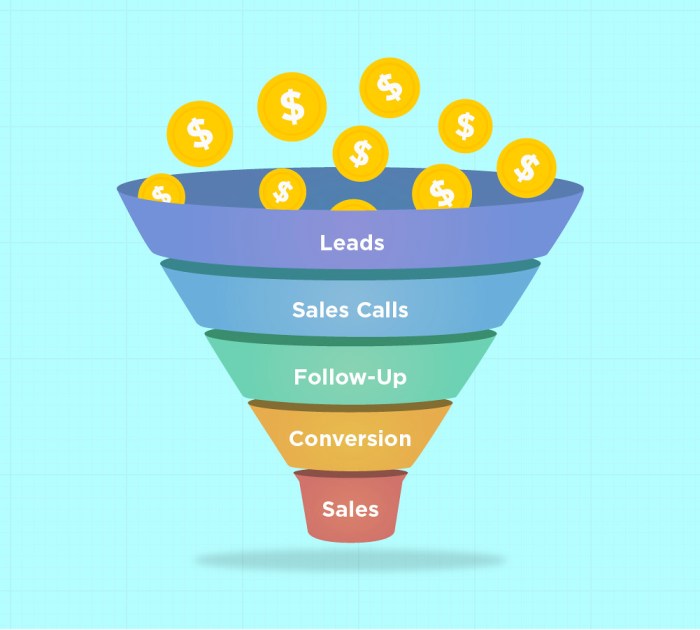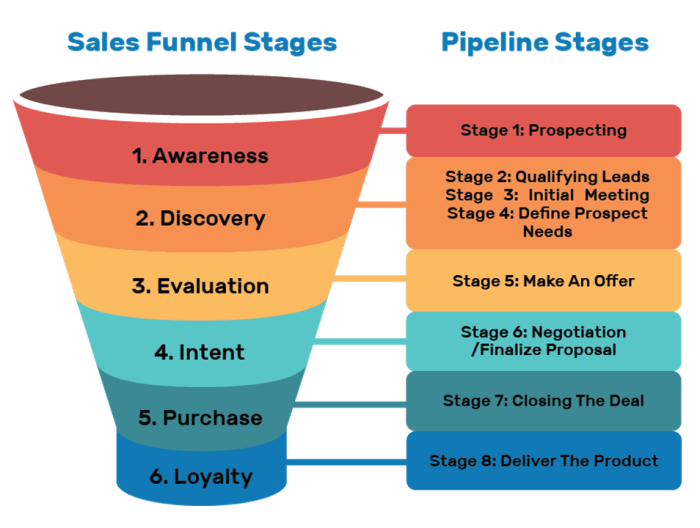Understanding Sales Funnels sets the stage for boosting conversion rates and enhancing marketing strategies across various industries. Dive into the world of sales funnels to uncover the secrets behind successful customer journeys.
Exploring the different components and stages of sales funnels reveals the intricate process of guiding leads towards making a purchase, ultimately driving business growth and success.
Definition of Sales Funnels

Sales funnels are a marketing concept that represents the journey a potential customer goes through before making a purchase. It involves guiding the customer through different stages, starting from awareness of a product or service to the final purchase decision.
Examples of Sales Funnels in Different Industries
- In the e-commerce industry, a sales funnel may start with a social media ad leading to a product page, then a shopping cart, and finally, the completion of a purchase.
- In the real estate industry, a sales funnel could begin with a lead generation form on a website, followed by a property viewing, negotiation, and eventually, closing the sale.
- In the software industry, a sales funnel might involve a free trial offer, followed by email nurturing, a demo of the product, and finally, a subscription purchase.
Stages of a Typical Sales Funnel
- Awareness: Potential customers become aware of a product or service through marketing efforts such as ads, social media, or content.
- Interest: Customers show interest by exploring more about the product, researching, or engaging with the brand.
- Decision: Customers evaluate the options, compare with competitors, and decide whether to make a purchase.
- Action: The final stage where the customer makes the purchase, completing the sales funnel.
Importance of Understanding Sales Funnels
Businesses need to comprehend sales funnels to optimize their sales process and increase revenue. By understanding how customers move through the sales funnel, businesses can tailor their marketing strategies and messaging to better target potential customers at each stage of the funnel.
Improving Conversion Rates, Understanding Sales Funnels
Understanding sales funnels can significantly improve conversion rates for businesses. By analyzing each stage of the funnel, businesses can identify potential bottlenecks or areas for improvement in the sales process. This allows them to make targeted adjustments to their marketing efforts, resulting in higher conversion rates and ultimately, increased sales.
Businesses that Understand vs. Those that Don’t
- Businesses that understand sales funnels are more likely to have a clear understanding of their target audience and their specific needs at each stage of the buying process. This enables them to create more personalized and effective marketing campaigns that resonate with their customers.
- On the other hand, businesses that do not understand sales funnels may struggle to identify the needs and preferences of their target audience. This can lead to generic marketing campaigns that fail to engage potential customers at different stages of the sales process, resulting in lower conversion rates and missed opportunities for growth.
Components of a Sales Funnel

When it comes to understanding sales funnels, it’s crucial to grasp the key components that make up this essential marketing strategy. Each component plays a vital role in guiding potential customers through the buying process, ultimately leading to conversions.
Lead Magnets
Lead magnets are incentives offered to prospects in exchange for their contact information. These can take the form of ebooks, guides, webinars, or discounts. The main goal of lead magnets is to attract leads and start building a relationship with them. They help in capturing the attention of potential customers and nurturing them through the sales funnel.
- Lead magnets provide value to prospects, establishing trust and credibility.
- They encourage prospects to take the first step in engaging with your brand.
- By offering something of value for free, you can collect contact information for further marketing efforts.
Email Marketing Integration
Email marketing plays a crucial role in nurturing leads and guiding them through the different stages of the sales funnel. It allows businesses to communicate with prospects on a more personal level, providing them with relevant content and offers based on their interests and behavior.
Email marketing helps in building relationships with leads, increasing brand awareness, and driving conversions.
- Automated email sequences can be set up to send targeted messages to leads at the right time.
- Personalization in emails can enhance engagement and encourage prospects to move further down the funnel.
- Email marketing metrics provide valuable insights into lead behavior and help in optimizing the sales funnel for better results.
Designing an Effective Sales Funnel: Understanding Sales Funnels
Creating a successful sales funnel requires careful planning and strategic implementation. Here are the steps to design an effective sales funnel:
1. Define Your Target Audience
- Research and identify your target market.
- Understand their needs, preferences, and pain points.
- Create buyer personas to tailor your funnel to their specific requirements.
2. Artikel Your Sales Funnel Stages
- Determine the different stages your customers will go through before making a purchase.
- Typical stages include awareness, interest, decision, and action.
- Create content and strategies for each stage to move leads through the funnel.
3. Develop Compelling Content
- Produce high-quality and engaging content that resonates with your audience.
- Utilize various formats such as blog posts, videos, webinars, and case studies.
- Ensure your content addresses customer pain points and provides solutions.
4. Implement Automation and CRM Systems
- Use marketing automation tools to streamline the process and nurture leads.
- Integrate a Customer Relationship Management (CRM) system to track customer interactions.
- Personalize communication and follow-ups based on customer behavior.
5. Optimize Each Stage of the Funnel
- Continuously monitor and analyze performance metrics for each stage.
- Identify bottlenecks or areas of improvement and make necessary adjustments.
- A/B test different elements such as headlines, CTAs, and images to optimize conversions.
6. Conduct A/B Testing
- Split test different variations of your landing pages, emails, and ads.
- Compare the results to determine which version performs better.
- Use the data to refine your sales funnel and improve overall conversion rates.
